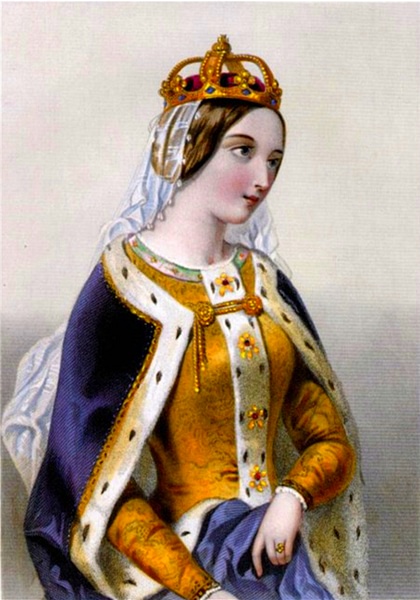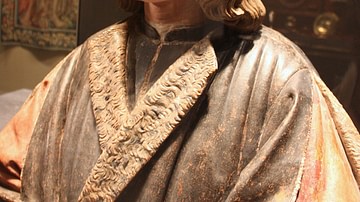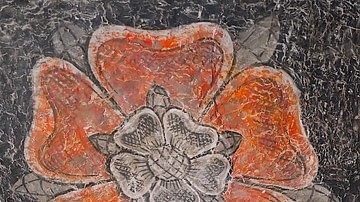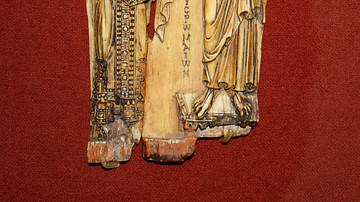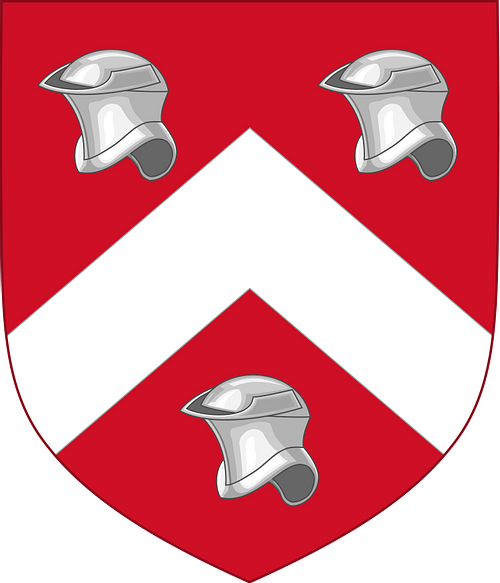
Owen Tudor, aka Owain ap Maredudd ap Tudor (c. 1400-1461 CE), was a Welsh courtier who secretly married Catherine of Valois (l. 1401 - c. 1437 CE), the former wife of Henry V of England (r. 1413-1422 CE) and mother of Henry VI of England (r. 1422-61 & 1470-71 CE). The couple had several children, one of whom was Edmund Tudor whose son Henry Tudor would become Henry VII of England (r. 1485-1509 CE) and so found the royal house of Tudor. The Tudors would rule England until 1603 CE in what many regard as the country's Golden Age. Owen Tudor, a staunch supporter of Henry VI during the Wars of the Roses (1455-1487 CE) dynastic dispute, was captured and beheaded by Yorkist forces in 1461 CE.
Catherine of Valois
Catherine of Valois was the daughter of Charles VI of France (r. 1380-1422 CE) and she married Henry V of England in Troyes Cathedral on 2 June 1420 CE. This marriage was a result of Henry's great victory against the French at Agincourt in 1415 CE during the Hundred Years' War (1337-1453 CE). When the English king followed this up with the capture of Normandy and Paris, he was able to negotiate the favourable Treaty of Troyes in May 1420 CE. According to this treaty, Henry would be made the king of France following the death of Charles VI. The new regime would be tied to the old via the marriage of Henry to Catherine. Unfortunately, Henry died, probably of dysentery, in 1422 CE and he missed the chance to become the king of France by less than two months; Charles VI died on 21 October 1422 CE. Henry was succeeded by his infant namesake son, crowned Henry VI in November 1429 CE.
Catherine, now an ex-queen and mother of the reigning child-king, was not content to live a retired life for the rest of her days. She had a secret affair with a Welsh nobleman who was a member of her household. The historian Nigel Jones gives the following account of how their affair began:
Catherine of Valois was left bereft, a lusty young woman in the prime of life. She did not remain single for long. Owen Tudor, a handsome young Welshman of obscure origins, had become her Keeper of the Wardrobe. According to romantic rumour Owen had caught the queen's notice when he stumbled, incapably drunk, into her lap. Intrigued, she spied on him as he swam nude, [and] liked what she saw…
(99-100)
Owen's background may be obscure but we do know that he was born around 1400 CE, the son of Meredudd Tudor and Margaret, daughter of Dafydd Fychan. The Tudors, or Tewdwrs, were kings of Deheubrath and held estates in north Wales. They would soon rise even higher and come to hold two earldoms in England, granted to them by Henry VI, who acted as a generous protector of his half-brothers and sisters.
Imprisonment & Death
The English Parliament prohibited Catherine from remarrying without either it or the king's consent in 1428 CE, but the former queen ignored this and secretly married Owen anyway. The union was kept secret until 1436 CE, but when it became public knowledge, Catherine was obliged to retire to a nunnery at Bermondsey outside London where she died prematurely the next year. Owen fared even worse and was locked up in Newgate Prison. The Welshman managed to escape in 1438 CE and went into hiding in his native Wales. Owen's fortunes improved when he raised an army to support Henry VI but after the battle at Mortimer's Cross in February 1461 CE, Owen was captured by Yorkist forces. He was then beheaded in Hereford marketplace as the Wars of the Roses, the dynastic dispute between the House of Lancaster and the House of York raged on.
According to tradition, when Owen faced his imminent execution, he had lamented that: "the head that had once lain on Queen Catherine's lap would now lie on the executioner's stock" (quoted in Jones, 107). After the dreadful sentence was carried out, it was said that a local madwoman had cleaned the head, combed the hair and surrounded it with candles as that particular day was the feast of Candlemas. Owen Tudor was buried at Greyfriars in Hereford.
Birth of the House of Tudor
Owen Tudor and Catherine of Valois had five children - three sons and two daughters - and so the Tudor Dynasty was born. One of the couple's sons was Jasper Tudor, Earl of Pembroke (l. 1431-1495 CE) who would later effectively rule Wales for the English monarchy. Another son was Edmund Tudor (l. 1430-1456 CE), Earl of Richmond, who married Margaret Beaufort (l. c. 1441-1509 CE), the great-granddaughter of John of Gaunt, Duke of Lancaster and son of Edward III of England (r. 1312-1377 CE). Edmund and Margaret had a son, Henry Tudor (b. 1457 CE) who could claim through his mother, albeit distantly, an illegitimate connection to the House of Lancaster. Henry Tudor never knew his father Edmund as he died of plague three months before he was born.
Through a series of deaths and mishaps, and, after the defeat at Mortimer's Cross and the exile of his uncle Jasper Tudor to France, Henry Tudor became the leading Lancaster candidate for the throne of England during the final stages of the Wars of the Roses. Curiously, Henry was known at the time as Henry of Richmond (after the earldom he had inherited from his father) and, despite the love modern historians have for labelling all things 'Tudor' for the period, the Tudor surname was very little used by him or his successors.
As head of the Lancaster cause, Henry went on to challenge and topple the unpopular Yorkist king Richard III of England (r. 1483-1485 CE) and was crowned Henry VII of England in 1485 CE, the first Tudor monarch. When Henry VII married Elizabeth of York (1466-1503 CE), daughter of Edward IV of England (r. 1461-70 CE & 1471-83 CE) in 1486 CE, the two rival houses of York and Lancaster were finally united. The monarchs over the next century would now be Tudors and include such great names as Henry VIII of England (r. 1509-1547 CE) and Elizabeth I of England (r. 1558-1603 CE).
